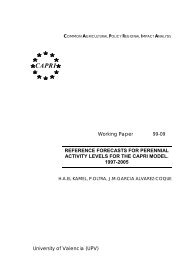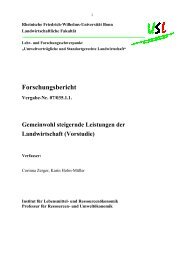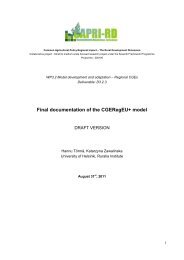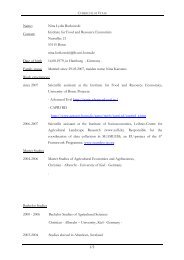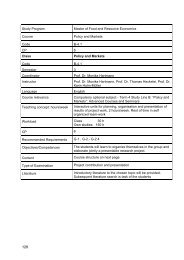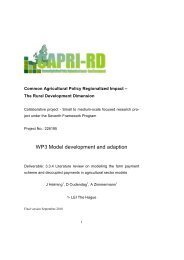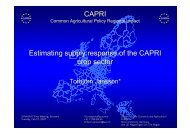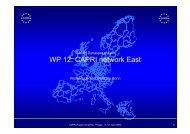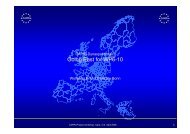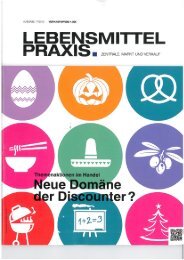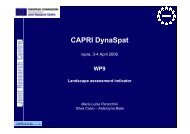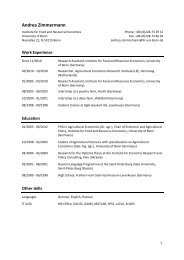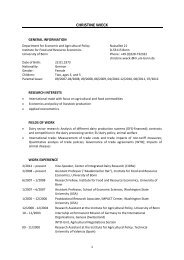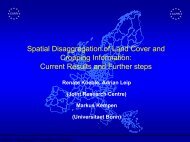Research proposal of sub-project B2 for second phase - Institut für ...
Research proposal of sub-project B2 for second phase - Institut für ...
Research proposal of sub-project B2 for second phase - Institut für ...
Create successful ePaper yourself
Turn your PDF publications into a flip-book with our unique Google optimized e-Paper software.
FOR1501 – RCR (2)<br />
<strong>B2</strong>: Resilience <strong>of</strong> SES from a Resource Economics Perspective<br />
A. Project Description / Beschreibung des Vorhabens<br />
Pr<strong>of</strong>. Dr. Thomas Heckelei, University <strong>of</strong> Bonn<br />
[DFG <strong>for</strong>m 54.012 – 1/12]<br />
I. PROJECT DESCRIPTION / BESCHREIBUNG DES VORHABENS<br />
1. STATE OF THE ART, WORK IN PHASE I / STAND DER FORSCHUNG, ARBEIT IN<br />
PHASE I<br />
1.1 State <strong>of</strong> the Art<br />
The overall objective <strong>of</strong> <strong>B2</strong> <strong>for</strong> <strong>phase</strong> II is to assess the resilience <strong>of</strong> SES in Kenya and South<br />
Africa using numerical simulation models that are innovatively specified to make the best use<br />
<strong>of</strong> collected data. Compared to the vast number <strong>of</strong> theoretical and conceptual studies,<br />
empirical research assessing the resilience <strong>of</strong> SES is still in an exploratory <strong>phase</strong>. Apart from<br />
the challenge <strong>of</strong> defining ‘resilience <strong>of</strong> an SES’, practical problems arise from the fact that<br />
regime shifts in SES are observed with low frequency, while experiments aimed at pushing<br />
SES towards critical thresholds are impossible <strong>for</strong> ethical reasons (Carpenter et al. 2005).<br />
One <strong>of</strong> the first attempts to assess the resilience <strong>of</strong> SES based on qualitative case studies is<br />
made by Berkes and Seixas (2005), who look <strong>for</strong> factors influencing resilience <strong>of</strong> five lagoon<br />
fisheries on different continents. They identify the role <strong>of</strong> social learning, organizational and<br />
knowledge diversity, and opportunities <strong>for</strong> self-organization as important clusters <strong>of</strong> factors<br />
<strong>for</strong> building resilience <strong>of</strong> SES. On the other hand, breakdown <strong>of</strong> resource institutions, rapid<br />
technological and socio-economic change, and institutional instability across political scales<br />
have the potential to weaken resilience. In another case study, Marschke and Berkes (2006)<br />
investigate the livelihood resilience <strong>of</strong> Cambodian fishing communities using a mix <strong>of</strong><br />
qualitative and quantitative methods. They point out the importance <strong>of</strong> poverty traps, thereby<br />
questioning the positive connotation <strong>of</strong> resilience, and consequently suggest well-being as a<br />
‘culturally appropriate surrogate’ <strong>for</strong> positive resilience.<br />
Sallu et al. (2010) assess the vulnerability and resilience <strong>of</strong> livelihoods in drylands <strong>of</strong> rural<br />
Botswana in a multi-disciplinary study spanning an investigation period <strong>of</strong> three decades.<br />
They develop ‘resilience narratives’ based on the analysis <strong>of</strong> livelihood trajectories and<br />
illustrate the combined influence <strong>of</strong> environmental variation and institutions in determining a<br />
household’s access to assets and, consequently, its ability to generate more resilient<br />
livelihood outcomes. A number <strong>of</strong> other studies take a historical perspective to work out<br />
resilience narratives, as <strong>for</strong> instance Newton (2011), who gives an account <strong>of</strong> a 900-year old<br />
<strong>for</strong>est reserve in England. The impact <strong>of</strong> fundamental changes <strong>of</strong> Chinese economic policy<br />
regimes on the degree <strong>of</strong> coupling and resilience <strong>of</strong> pastoral SES in Inner Mongolia is<br />
discussed (Li & Li 2012), and <strong>for</strong> agro-<strong>for</strong>estry communities in Sichuan (Urgenson et al.<br />
2010). A more structural approach <strong>of</strong> providing empirical resilience assessments is based on<br />
the concept <strong>of</strong> the adaptive cycle (Gunderson and Holling 2002). A comparative study <strong>of</strong> five<br />
national Pacific salmon fisheries (Augerot and Smith 2010) attempts to determine the current<br />
status <strong>of</strong> each individual fishery within the cycle, while a long-term study <strong>of</strong> a single Sahelian<br />
village since the severe drought <strong>of</strong> the early 70’s monitors the movement <strong>of</strong> the agro-pastoral<br />
SES through the adaptive cycle.<br />
Examples <strong>of</strong> numerical models explicitly simulating the resilience <strong>of</strong> SES are still rare. A<br />
generic model is proposed by Fletcher and Hilbert (2007) which measures resilience as the<br />
“size <strong>of</strong> the basin <strong>of</strong> attraction near a desirable equilibrium and the return time following small<br />
A. Proposal Data and Obligations / Daten zum Antrag und Verpflichtungen 5



